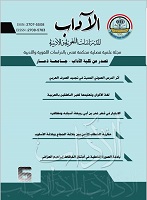Rhetorical Style of Visual Calligraphy in the patterns of the Calligrapher Ibrahim Al-Arrāf
DOI:
https://doi.org/10.53286/arts.v1i6.268Keywords:
البلاغة الجديدة, الصورة الخطية, المشق, الشعرية, التداولAbstract
This research aims at unveiling (the rhetorical style of visual calligraphy in the patterns of the calligrapher Ibrahim Al-Arrāfi) as one of the artists who enriched the creative movement in Saudi Arabia, and one of those who contributed in teaching the new generation at the Holy Mosque in Mecca until his artistic activity and innovative experiment became an integral part of the contemporary creative movement in the Arab world. The aims of the research are established and justified, having belief that calligraphic patterns possess features of creativity, admiration and critical works.In this way, the research went on -in the light of Modern rhetoric- to approach the compilation of the calligrapher Al-Arrafi titled “Pattern: the Scale of Arabic Calligraphy”. Meanwhile, what is desired from comparing selected samples out of his Calligraphic Patterns is to answer this methodological question that will determine the research direction and draw the critical engagement horizon and objectives of the research: What are rhetorical capabilities that granted the visual calligraphy in the patterns of the calligrapher Ibrahim Al-Arrāfi its creative power and conviction efficiency? From the question that imposed its implicit authority on the substance of the research, its interests were determined between poetry as the fruit of imagination and conviction as the fruit of pragmatics.Downloads
Downloads
Published
How to Cite
Issue
Section
License
Copyright (c) 2021 فوزي علي علي صويلح، عبد الله علي صالح الجوزي

This work is licensed under a Creative Commons Attribution 4.0 International License.
Copyright and Licensing
copyright is retained by the authors. Articles are licensed under an open access Creative Commons CC BY 4.0 license, meaning that anyone may download and read the paper for free. In addition, the article may be reused and quoted provided that the original published version is cited. These conditions allow for maximum use and exposure of the work.



